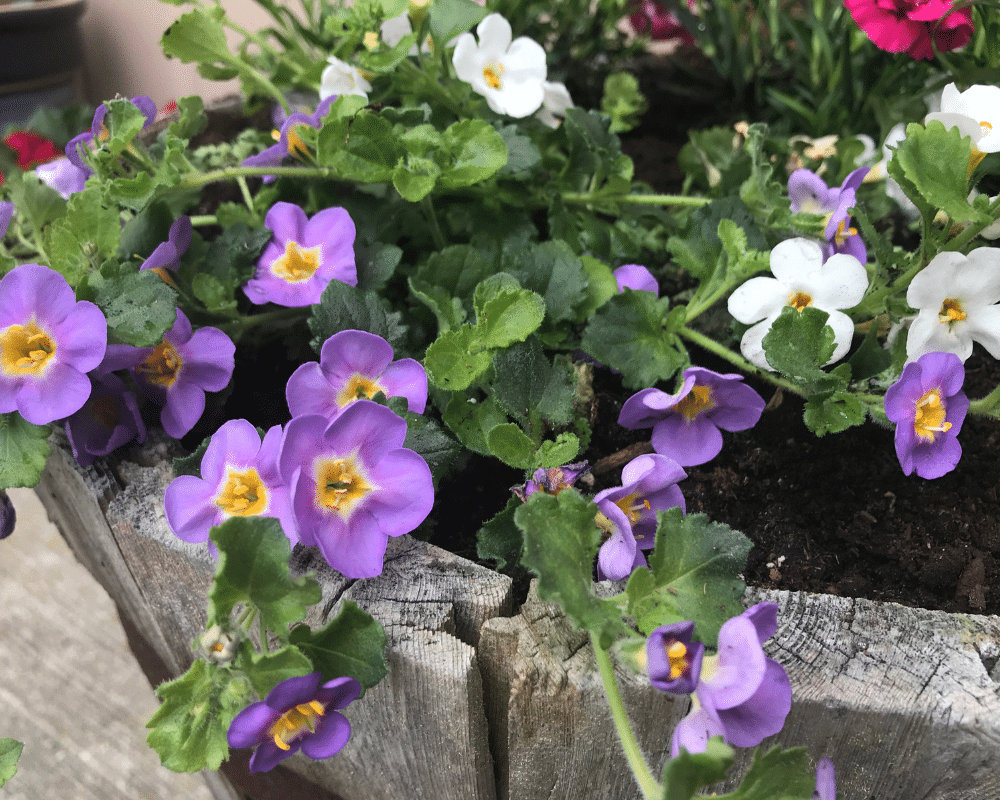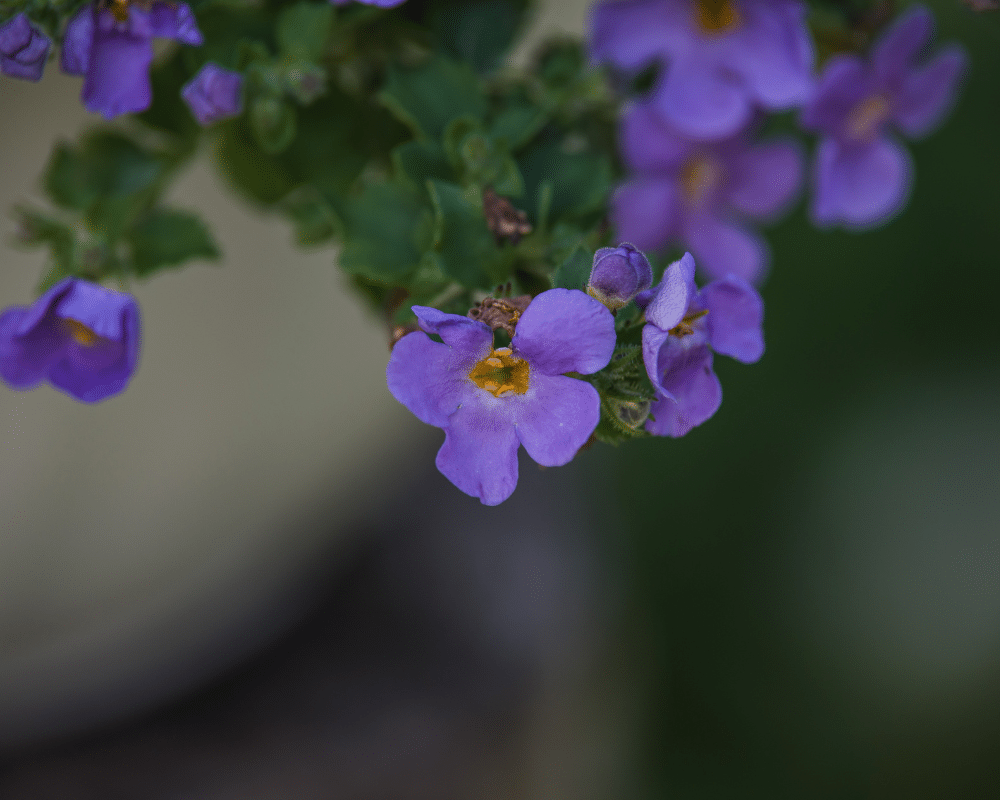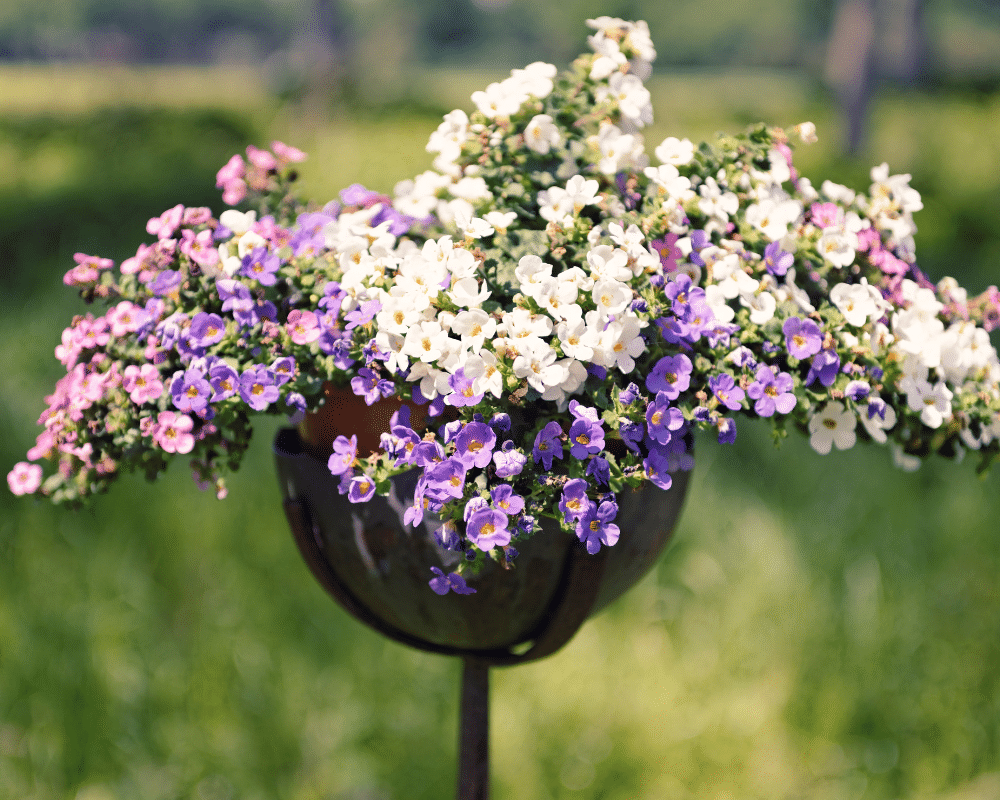Tiny, Star Like Blossoms
Here is how to keep your Bacopa in bloom. It’s Tiny, lush, and star-like, this ornamental Bacopa is Chaenostoma cordatum, formerly Sutera cordata (SOO-ter-uh kor-DAY-tuh) is a warm-weather perennial in zone 9-11. Elsewhere, consider it a charming and useful little plant to trail from your containers. It looks tiny in the garden center, but it will trail several feet.
How We Can Use It
This is very attractive in any container. Window boxes, hanging baskets, all sorts of containers. It is available to us in white and near white, blues, pinks, and lavenders. The flower is small but relatively large in relation to the tiny heart-shaped leaves. The flower’s importance is enhanced by the fact that it is raised above the leaves on an upright peduncle. (That is the stalk that bears the flower.)
Flowers and Foliage
The dark green leaves are tiny and roughly heart-shaped. The flower is very small, but they cover the plant, and each flower will last for a week. Expect very good flower coverage, and the plant blends well with other ornamentals. You will find it a valuable accessory to any container.
I have added it to an area of white plantings in the swimming pool area. We like the white because it is lovely to sit out on our warm evenings and enjoy the “Moonlight Garden” effect. This post is a visit to Mina Edison’s historic moonlight garden at the Edison-Ford Estate in Fort Myers, Florida. If you visit the area, it is a great day out along the wide Caloosahatchee River.

How It Got To Us
The earliest mention of this plant, I see, is by the early plant hunter Carl Peter Thunberg (1743-1828). An interesting and dedicated character, he was a physician and student of Linnaeus.
Thunberg spent three years in South Africa, seeking plants for the Botanical Garden in Leyden. Later he traveled in Japan. The Japanese tried hard to be unaffected by Western traders. Finding himself isolated and unable to get to interesting botanic material, he traded medical knowledge to get access to plants. Providing information to the Japanese translators apparently worked for him. “Where there is a will, there is a way”?
He called Barcopa by a slightly different name. It was later changed to Sutera cordata. Thunberg found the Bacopa plant in the rainy parts of South Africa-than will suggest its need for water.
Some Cultivars of Ornamental Bacopa

Here are cultivars to consider when you are shopping:
- Abunda Series
- African Sunset-small scarlet-orange flowers
- Blue Showers
- Bluetopia-lavender/blue flower, mounding form, trailing, long bloom period
- Calypso Jumbo White
- Candy Floss Blue
- Lavender Showers
- Lavender Storm
- Olympic Gold- green and white variegated leaves, white flowers
- Silver Rain
- Snowflake-small flowers
- Snowtopia-forms dense mat, 6″ h. Morning sun
- Snowstorm-sun to shade needs more water in sun, trails to 1.’ larger flowers
When a plant is popular, there are always new cultivars in testing. You will see new options over time. Look for them in the garden centers and read the labels.
How To Grow It –The Secret of Bacopa
Plant Bacopa starting in mid to late spring after the last frost in your area. The plant will not survive freezing temperatures and may not bloom in extremes of heat.
Use Bacopa in sun to part sun, avoiding places of high wind. With most flowering plants, for example, a petunia, the plant will wilt and warn you that water is needed. When the bacopa plant becomes completely dry, it stops blooming, and it can take two or more weeks to rebloom. After about two watering failures, the plant will simply give up on you.
Growing Conditions
Soil
Plant in containers in good quality potting mix kept steadily moist. It requires a pH of 5.6-5.9. Here are notes on selecting potting soil.
Planting in Hanging Baskets

Hanging baskets perform best with a light potting mix. Look for ingredients, including bark, peat, vermiculite, or perlite. Hanging baskets in the heat of summer will require daily water and sometimes even two waterings. If you plant several baskets, you may benefit from micro-drip systems.
Handy Note: The Bacopa roots allow for easy division. It is usually sold in 4″ pots. In containers and hanging baskets you can split the plant to cover around the edges of the pot.
“Choose the Best Potting Soil”
Light Requirements
Bacopa is rated for sun to part sun in the garden. In the more southern zones morning sun is best. Plants in the sun, particularly in warm weather, will require more water.
Fertilizer
Feed Bacopa with a balanced 10-10-10 feed. Recommendations range from feeding at 7-10 day intervals to 4-6 week intervals. In our garden, we favor the 7-10 day schedule using a liquid feed mixed on the garden hose. It is convenient and works for us. We garden in zone 10b. It is a warm climate, and we water more often than gardeners in colder climates. The heavier watering does remove fertilizer a little faster than may happen in a more temperate climate.
Water
Watering requirements bear repeating. Bacopa is an easy plant to grow. But it does not warn you, as many plants do, by wilting, that water is needed. It just drops the flowers, and it does not let you repeat your error many times!
Many growers suggest as companion plants, those that will wilt and warn you if you forget. These might include petunia or coleus, for example.
Propagation
You can propagate cuttings either in water or seed-starting soil. Cut the stem just below a node, and remove the lower leaves. You can root them in water or soil. A pencil is a good way to make soil holes.
Include a node because it includes the most growth hormone. Also, remember to cut the stem part that remains on the plant just above a node. This will encourage the plant to grow and avoid a dead stem area that might become diseased.
Pruning
As a trailing plant, it will become long. Prune it to the size you require; deadheading is not required as bacopa is self-cleaning.
Pests And Diseases
Pests
Like Louie in “Casablanca,” we can “round up the usual suspects.” These would be Aphids, Thrips, and Whiteflies; if you see, the little bodies start with the simplest cures. Remove affected leaves and destroy them. Use water pressure from the garden, and if they persist, use insecticidal soap.
Diseases
- Botrytis is a fungus that attacks a variety of plants. To avoid disease, control the environment. Remove dead plant material and debris, Improve air circulation, and avoid overhead watering if possible.
- Pythium is a fungus-like organism. The plant will appear stunted, turns yellow, and dies. It tends to be caused by dirty tools. Pots or flats. To avoid the problem, use heat-pasteurized potting soil and cleaning tools and equipment. Potting soil can be reused if amended with new material but never reuse soil from a plant that died of a disease.
- Rhizoctonia is a soilborne fungus that causes root rot. Good drainage and fungicide use are ways to handle the problem.
Summary
Our mothers and grandmothers loved their bright annuals. They used the ancestors of the Impatiens we use today. The Bacopa they never saw. It is a plant with lots of uses in our gardens.
Companion Plants
This little trailing plant can be used on its own to create lovely mounding containers. Combine them with other plants for your own look. Upright begonias will complement the form of Bacopa. Try Calibrachoa, coleus, angelonia, Petunia, and petchoa. For more trailing forms, use lobelia and sweet potato vine.
In the pool area, we have used Bacopa to replace white Petunia, which by April were giving up the ghost. They are potted with Angelonia for height and euphorbia for an airy fullness, and they all surround a little Kumquat tree, now in bloom. This container is in full sun in a warm climate. It is in a screened swimming pool cage which reduced the rays by 30%.
Sun Companions-zonal Geraniums, Wave Petunia, Licorice Vine, and the Sweet Potato Vine “Blackie.
Part Sun Companions-Impatiens, Coleus, Caladium.
The Bacopa should be fun and useful in the garden. Here is some more information from North Carolina State University.
